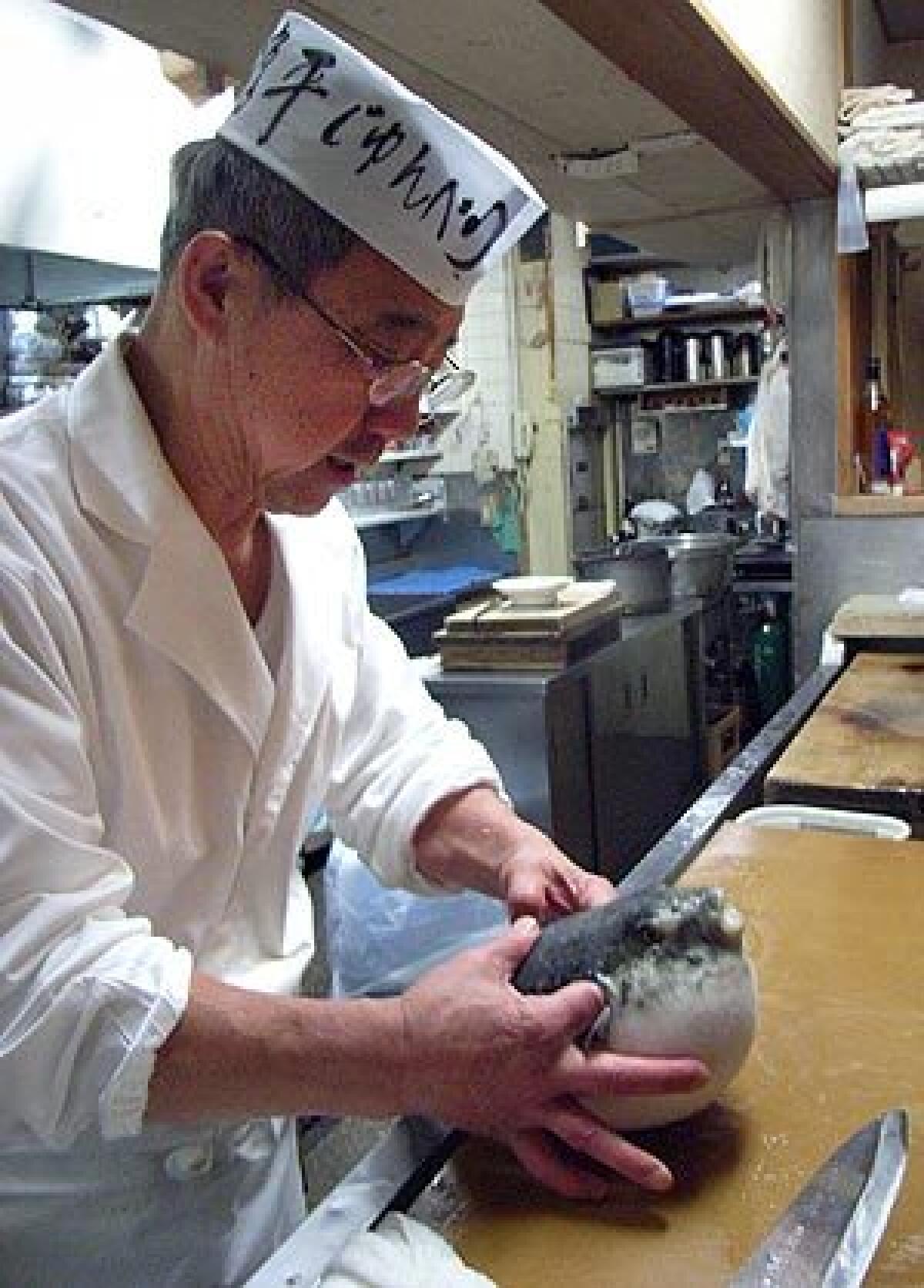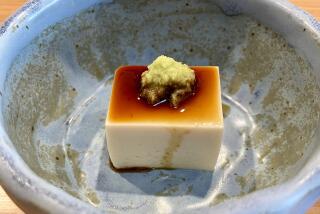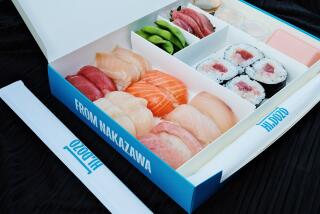Blowfish’s bad rap is killing him

- Share via
Reporting from Tokyo — Veteran chef Yutaka Sasaki has a plan to remove the fear of eating one of the most poisonous fish on the planet: He wants to feed it to the emperor.
The blowfish, known here as fugu, carries a deadly neurotoxin with no known antidote. An average-sized fugu is chock-full of the poison tetrodotoxin -- in its blood, liver and even its sex organs, Sasaki says.
But he scoffs at the centuries-old ban on the Japanese monarch eating the delicacy, sought after by many Japanese as daring cuisine.
“The prince and other royalty have eaten fugu, so why not the emperor?” he says. “It would set a good example.”
After all, he argues, it’s only deadly in the wrong hands.
“Someone who tries to prepare meals they know nothing about is stupid,” says Sasaki, 61. “If you’re a chef and you don’t know this fish, you shouldn’t even touch it.”
Chefs such as Sasaki are campaigning to change fugu’s notorious image as Russian roulette on a plate. When prepared by a licensed chef, they say, the meal is as safe as biting into a Big Mac.
In 30 years, Sasaki says, no one has become sick eating his fugu. He has taught countless other chefs, including his son, who works alongside him in the family’s Tokyo restaurant, Tairyo, or “good catch.”
Japanese are the largest consumers of fugu, eating 10,000 tons a year. An elegant multicourse meal of it can cost a diner $450.
Sasaki shakes his head over connoisseurs being attracted to fugu not for its flavor (described as “a taste given by heaven”) but for its off-the-chart concentration of lethal toxins.
But for as many Japanese who are attracted by the danger, Sasaki says, there are more who fear the fish. Those are the new customers he wants to attract.
The chef’s English-language business card lampoons the image that eating blowfish is the gastronomic equivalent of bungee jumping with a frayed cord. “Try mysterious blow fish taste,” it tempts. “One hundred percent guarantee to you stay alive.”
But there are problems with that pitch: Some fugu gourmets don’t last long enough to order dessert.
Over the last dozen years, Japan has had hundreds of cases of “poison by fugu,” as many as 34 of them fatal, Japanese health officials say.
Early this year, six men in northern Japan were poisoned when they ate grilled blowfish testicles prepared by an unlicensed chef, now under investigation by police. The men survived.
Lax oversight is another obstacle.
Although there are tens of thousands of Japanese fugu chefs -- 80,000 in the Osaka area alone -- the industry has no centralized regulation, so it’s difficult to know how many are licensed, says Kiichi Kitahama, a well-known chef and owner of a fugu museum in Osaka.
In addition, only 19 of Japan’s 47 prefectures require chefs to pass an exam to obtain a fugu license, and those tests vary in their demands. In Tokyo, a chef must serve a three-year apprenticeship and pass a stringent test that involves gutting a fugu under the scrutiny of health officials.
Fugu guts are so poisonous that they must be kept under lock and key and disposed of like some sort of restaurant radioactive waste.
“There’s much more work to make fugu legitimate,” Kitahama says. “That’s why I am still working at age 81.”
Kitahama is known as the godfather of fugu research. In 1913, his father opened the Osaka fugu restaurant where Kitahama started working as a chef at 16 -- and remains to this day.
In the 1950s, he became alarmed by the high death and injury rate associated with the fish -- 400 killed and 31,056 sickened in one year alone, Kitahama says.
In 1975, when a famous Kabuki actor died after eating a blowfish liver, Kitahama began to study the fish in earnest.
He collected preserved specimens, skeletons, photos, slides and paintings that are now on display in his museum.
His research inspired chefs such as Sasaki, who remembers that friends who first took him to a restaurant that served fugu wouldn’t allow him to sample it.
“They said the fugu experience was too dangerous,” he says. “So they fed me only vegetables, not the fish.”
He is a touch arrogant about his craft: I am a chef and I have a license, his tone implies. Do you want to eat this or not?
Working cautiously, more surgeon than chef, he demonstrates how to prepare the still-wriggling delicacy in the tiny kitchen of his restaurant
“Watch this,” he says, applying pressure that causes the struggling fish to puff up into a prickly ball. After delivering a mallet blow to the head, Sasaki begins slicing into flesh, removing the still-beating heart.
He’s happy to show customers his technique for an extra $100.
“I’m an entertainer, not a regular chef,” he says. “I have to make my work a performance to show people this fish in my hands is safe to eat.”
But he continues to battle stereotypes, like the one that says a diner’s lips turn numb with a good piece of fugu.
“That’s a lie,” he says. “If you’re eating fugu and your lips turn numb, you’re well on your way to being dead.”
More to Read
Sign up for Essential California
The most important California stories and recommendations in your inbox every morning.
You may occasionally receive promotional content from the Los Angeles Times.














